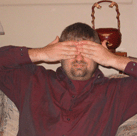So this was cool. Its a story I saw tonight on Nova. I have to admit to have become more of a Frontline guy lately, but Nova still catches my attention every now and then.
The story was about some famous, old, tapestries, a famous, old, museum, and a pair of famous, old, mathematicians. That and the less famous, less old process of digital archiving.
Apparently the Metropolitan Museum in New York had these tapestries in as a visiting exhibit. Also while they were there they were going to do some cleaning and restoration and then do very high resolution photos of the entire piece for their ever growing digital archive. The idea was to shoot photos with a resolution sufficient to see what was happening with each thread of the tapestry. The piece is 30' tall. They were shooting 30"x30" images, very high resolution and very long exposures.
Image files as I am sure those of you with dial-up will attest are large. The files they were generating were huge. So huge that their computer could only handle one at a time. The mathematicians got involved because they were interested in writing an analysis that would allow a computer to stitch together these very large images without any optical clues - all from the data.
The mystery begins when they complete their work and look at the finished aggregate image only to see that it doesn't line up. That is to say that pieces of each part of the mosaic of images line up, but other pieces don't. So it is more than a matter of just shifting a tile. They check the data, check the camera gantry, make sure the piece wasn't shifted accidentally while being scanned - at this point I figured it was going to be something about how the subway line runs directly under the building.
Turns out it was none of those things. I'll finish this up as a comment in case you want to watch the episode rather than read the answer here.
Tuesday, July 26, 2005
Hold Still!
Posted by
David
at
11:38 PM
![]()
Subscribe to:
Post Comments (Atom)


1 comment:
In the end, by doing some very complex studies on just how and where the errors were occuring they came to the conclusion that although the building, camera, and the tapestry itself were not moving that the individual threads were.
The combination of the cleaning & restoration and the fact that they were no longer hanging vertically were causing individual threads to stretch and recoil independently. This was making the tapestry shift even though the piece as a whole wasn't moving.
Truth be told, due to temperature and humidity and the fact that there are different kinds of yarn and thread in most tapestries, they must all be shifting like this all the time - you just never notice unless you tile it and try to compare extreemly detailed, long exposure photos.
So, with the mystery solved, they write a transformation program to best match the pieces based on the motion.
Something that interested me was that they didn't bring up that this really, in the end, isn't a photo of the original piece, as the computer is interpreting the information it has to compose a final composite. So it is as faithful as it can be, but it is and must be fundimentally flawed.
I think I am going to remember this as a good way to describe some of the problems inherent with digital audio. It isn't exactly spot on, but I think it does start to explain why a very good analog recording is better than a digital recording.
Essentially the Met's pictures were a digital video with a very small sampling rate. The smoothing they had to do to make the tile match is the same kind of interpolation you have to do whenever you do A to D conversion. Its just in this instance you can really see the difference with your own eyes.
Post a Comment